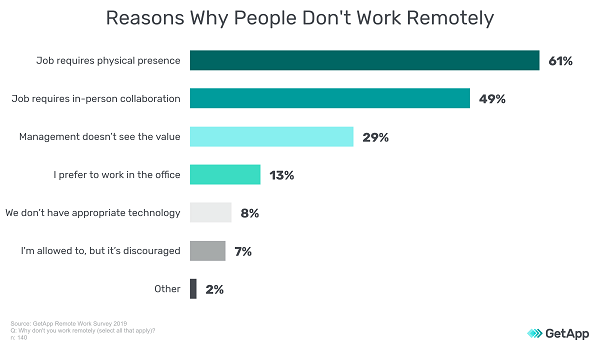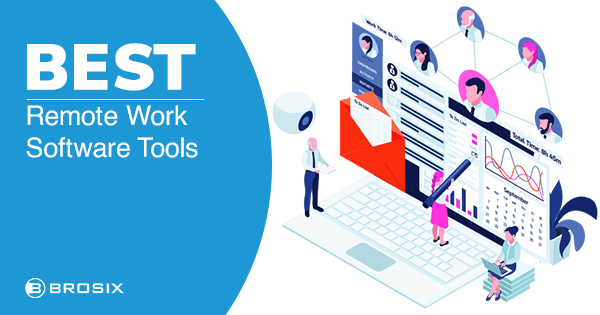Long before the Coronavirus pandemic, remote work was a growing reality. A study from before the COVID-19 crisis found that a third of full-time workers were expected to be remote by 2028.
And why not? Innovation in technology means that teamwork and tasks once limited to the office can now be completed anywhere. What’s more, remote working conditions can positively benefit flexibility, company costs, employee health and wellness, and even the environment.
[bctt tweet=”Your Company Needs a Remote Work Policy. Here’s What to Include.”]
Worryingly, the same study found that more than half of companies lack remote work policies. As the nature of work changes, there aren’t always clear ground rules, guidelines, or expectations in place for remote workers.
Without a proper policy in place, your remote teams face:
- Poor productivity
- Inefficient and ineffective workflows and processes
- A lack of data and information security and confidentiality
To mitigate these potentially serious consequences, your company needs a remote work policy. This will help keep productivity levels high and motivate your remote work employees into performing their best.
Here’s what to include.
1. Establish Who’s Eligible to Work Remotely
Under normal circumstances, you’d need to establish who’s eligible to work remotely. With that in mind, once the Coronavirus pandemic begins to wind down, you may use these guidelines to determine eligibility.
Analyze workflows, interactions, dependencies, and criticality to daily office functions. Jobs that require physical presence and in-person collaboration often aren’t suitable for remote work. For instance, those operating critical equipment, handling secure or hazardous materials, or regularly interacting with customers and clients may not be able to work remotely.

Image Source: GetApp
On the other hand, some of the jobs most conducive to remote work include:
- Writers and Editors
- Developers
- Translators
- Online Teachers
- Designers
- Accountants
As more companies outsource or move operations online, the number of remote positions in a wide array of fields is growing. If the majority of an employee’s tasks can be completed with the right software and a solid internet connection, that position can likely be executed remotely.
It’s also a good idea for new employees to pass their probationary period before granting them remote work privileges. This allows them to learn the tools of the trade while allowing you to gauge whether remote work suits them.
2. Set Ground Rules for Your Remote Workers
Setting ground rules may seem counterintuitive to the principle of remote work. That said, clarifying expectations of your remote workers reduces the chance of confusion or even misconduct as a result of unspoken rules or policies.
Accessibility
Defining accessibility requirements diminishes the chances of frustration between team members. If one employee is given flexible hours while another isn’t, it creates an unfair environment that could lead to conflict.
You may opt to institute a 9 to 5 policy or you could allow your employees to choose the hours that suit them best. Either way, this policy needs to be put in writing and agreed upon with each team member.
Reaction Time
Set guidelines regarding response times. Discuss with the employee(s) working remotely the timeframe in which they’ll be expected to react to a coworker or management. Clearly define this in the policy and specify which channels should be used for communication.
Defining these expectations helps mitigate worries over productivity and performance and fosters a better relationship between remote working team members and management.
A Defined Work Space
Depending on the nature of the work, you may have a preference as to where remote team members work. As the company is often liable for the employee during work hours, a remote work policy should outline the minimum remote working conditions, including basic health and safety standards and a dedicated workspace free from distractions.
[TIP: Sound advice on working remotely should complement your remote work policy. These work from home tips help you maximize remote workspaces, habits, and workflows.]
Just Termination
Management can be skeptical of remote work for the fact that, when employees are out of sight, access to them is more limited. Remote work is not grounds for termination, though, and this must be stated in the policy.
On the flip side, employees need to know that working remotely isn’t an opportunity to slack off. If an employee fails to fulfill their duties and responsibilities, the company reserves the right to terminate the remote working arrangement or even the employee.
3. Provide the Right Tech and Tools for Remote Work
A major advantage of remote work is that it eliminates some of the distractions and hassles of busy workplaces.
Editors, copywriters, designers, software engineers, and translators – to name a few – can greatly benefit from a calmer and quieter workspace, provided they’re equipped with the right tech and tools for remote work.
Clear Communication Channels

Without defined and reliable communication channels, the benefits of remote work can quickly succumb to headaches.
For more efficient communication, don’t rely on email alone. When team members want to check the accuracy of a translation, run by text edits for approval, or discuss the latest logo redesign, email is slow and threads can become cumbersome.
In many cases, instant messaging streamlines processes by keeping your team(s) in constant contact through a variety of channels.
Direct and group chat promote quick communication – think rapid-fire or yes or no questions. Voice and video calling thanks to VoIP technology facilitate more personal or detailed communication when it’s necessary.
[TIP: It’s not always easy to streamline and organize remote communication. Explore our tutorial on how to more effectively manage your team’s communication channels.]
Tech Tools for High-performance Remote Work
A thorough remote work policy makes clear whether employees will rely on company equipment or their own. This covers things like internet connectivity, laptops, mobile devices, and VPN service.
Remote workers also need tools to boost performance and maintain optimal levels of collaboration.
Instant Messaging Solutions for Business
Instant messaging solutions for business like Brosix easily align with any remote work policy.
In addition to their rich communication channels, features like screen-sharing with remote desktop control, unlimited size file transfers, instant screenshots, and virtual whiteboards enable dynamic team collaboration. Better yet, it’s all streamlined on one unified platform.
Project Management Software
Agile project management software is a must. Tools like Trello and Basecamp help you manage projects from start to finish. Regardless of scope, break down project components by setting goals, allocating resources, and tracking workflows. Delegate, coordinate, and track tasks including progress on both individual and team levels.
Productivity Apps
To maximize productivity, take advantage of rich administrative features, like Brosix’s. You’ll gain complete control over contacts, shared chat spaces, the features to which users have access, and more. Try Brosix and make your remote employees feel like they’re in the office.
You may also choose a productivity app like Buffer, Todoist, or TimeDoctor to help you efficiently manage mundane tasks such as automating social media posts, organizing to-do lists, or tracking time.
There are tools and software to satisfy any remote work policy. Regardless of the equipment you choose, provide your remote team the tech to succeed and specify this in the policy.
[TIP: Here’s a list of tech tools to keep your remote team connected and engaged during the COVID-19 pandemic]
4. Plan for Tech-related Issues
With equipment and tools come issues. While most companies have on-site tech support, remote work creates a whole new set of challenges.
You can’t schedule bugs, problems, and breakdowns. But you can have a contingency plan in place. Specify in the policy what action a remote worker needs to take when support-related issues arise.
[TIP: In many cases, business communication software can improve tech support. Remote desktop control, screenshots, live chat solutions, and effective communication channels can all assist with remote tech-related issues.]
5. Employ Rigid Security and Confidentiality Measures

Perhaps the most important challenge you face with your remote workers is ensuring the safety and confidentiality of company and client data. Removing this information from the confines of a secure work environment makes it much more difficult to safeguard.
“Getting started with remote work is simple, but getting it right is complicated. In the rush to adopt new technology, too many businesses put sensitive communications and data at risk by overlooking security concerns”
– Zach Capers, Senior Analyst at GetApp
If your team is expected to use a VPN while working remotely, make sure it’s up to date and that everyone knows how to connect. Moreover, if it’s necessary to forbid work from public places or unsecure networks, state this explicitly in the policy.
Always use encrypted communication via secure, private networks.
- Private team networks limit platform access to those whom you specifically authorize
- Peer-to-peer communication allows data and information to bypass potentially vulnerable cloud databases
- End-to-end encryption secures communications as readable by the sender and recipient only
- Anti-virus integration adds an extra layer of protection over your communications by scanning all sent and received files
To ensure maximum data and information security and confidentiality, these should be the minimum standards as defined by your remote work policy.
[TIP: Here’s a list of the most secure encrypted chat apps for communication with your remote team]
A Checklist to Implement Your Remote Work Policy
Now that you have clear company guidelines and guidance for working remotely, it’s time to implement your remote work policy.
For even the most seasoned employees, the leap to remote work can be a challenge. Set aside some time for your team to make sure they agree to the policy, understand it thoroughly, and have the equipment to productively work remotely.
Here’s a checklist to ensure the successful implementation of your remote work policy.
- Make sure all parties have reviewed and agreed to the ground rules and expectations.
- Establish expense accounts for internet, co-working spaces, and apps. Tools like Expensify can help you manage these expenditures.
- Equip your team with the necessary hardware and software including laptops, monitors, and communication and collaboration tools like Brosix, Trello, and Google Drive.
- Put in place contingency plans for when tech-related issues arise.
- Thoroughly review and strictly enforce security and confidentiality protocols.
Measure Your Remote Workers’ Effectiveness
Your remote work policy is only as good as the results it delivers. But results can be difficult to measure if you don’t know whether to track hours worked or work produced. What’s more, when your team is remote, you can’t just stop by their desk or meet at the water cooler.
No two teams are the same. So decide what success is for each team and every individual on it. Set attainable goals, clearly define key performance indicators, and monitor whether these goals and KPIs are met. Performance management software can help, but it’s not the only way to measure productivity.
A human-centric approach also allows you to measure the effectiveness of your remote work policy. Checking in regularly with your team ensures they’re not out of sight and out of mind.
Among the many benefits of instant messaging is that it’s built for regular check-ins. Quick but consistent communication with your remote team on a one-to-one or group basis via text, voice, or video can help you maintain and even boost camaraderie during the busy workday.
[bctt tweet=”Your Company Needs a Remote Work Policy. Here’s What to Include.”]
However you choose to measure success with your remote employees, include Brosix in your toolkit. Brosix easily aligns with remote work policies, enhancing them and keeping remote teams working effectively. Try it today!






